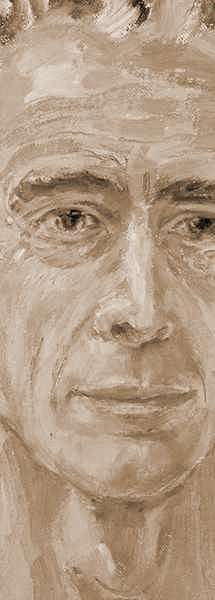|
 In
normal vision, all images are seen double except in the
plane of focus where the images received by both eyes
coincide. The varied, overlapping, and transparent doubled
images provide a fascinating new complexity of composition.
More significant from the plastic point of view, the
effects of normal vision with two eyes vastly intensify
the effects of three-dimensional space. While the basic
impulse of these paintings springs from careful observation
and analysis of the facts of natural vision, the pictorial
result is highly subjective and interpretive, since the
visual field is different for everyone and the intensity
of the images from either eye vary and shift. In
normal vision, all images are seen double except in the
plane of focus where the images received by both eyes
coincide. The varied, overlapping, and transparent doubled
images provide a fascinating new complexity of composition.
More significant from the plastic point of view, the
effects of normal vision with two eyes vastly intensify
the effects of three-dimensional space. While the basic
impulse of these paintings springs from careful observation
and analysis of the facts of natural vision, the pictorial
result is highly subjective and interpretive, since the
visual field is different for everyone and the intensity
of the images from either eye vary and shift.
For over 50 years, from 1931
until his death in 1994, Harold Haydon pursued a unique
compositional theory, which he called "binocular
vision." He saw it as revolutionary, a radical
new approach to painting composition just as significant
as Cubism. He hoped, of course, that artists would
rally around his invention and even feared at the beginning
that it might be stolen from him.
Haydon exhibited his work often
and wrote descriptions of it like the one above. He gave
lectures and demonstrations. There were press reviews
of his exhibitions and illustrations of his binocular
paintings in the media. Having been a member of the major
artists' organizations and having held office in several,
Haydon was active in the Chicago artists' community.
Clearly he was well known and liked, and other artists
knew his work. But Haydon was always disappointed by
the response he received to his binocular vision theory.
In a 1951 letter to an old friend he lamented that he
had "yet to see anything but superficiality and
misunderstanding on the part of art critics." Part
of the problem may be that while he was an able communicator
and described his work well, he never fully explained
how he derived the concept.
But, it is in "the how" and "the
why" that the real story lies. There we find not
only a complex, but also an extraordinarily fascinating
tale that shows just how much Haydon was a product
of his times. The early 20th century saw so many dramatic
changes, not only in the social and political climate,
but in educational reforms, art, music, literature,
philosophy and perhaps most stunning of all the advances
in modern physics that rewrote our very understanding
of reality. Into these years was born Harold Haydon,
the child of liberal and intellectual parents, a child
with a fertile imagination and thirst for knowledge,
and out of this experience would grow both his art
and his ability to synthesize the climate of his times.
|



